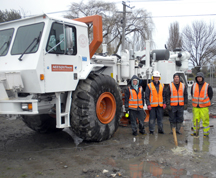Ground-improvement methods might protect against earthquakes
March 19, 2014
 |
|
Researchers are using T-Rex, a 64,000-pound shaker truck, in research to increase the resilience of homes and low-rise structures built on top of soils prone to liquefaction during strong earthquakes. T-Rex is based at a University of Texas at Austin facility that is part of the George E. Brown Jr. Network for Earthquake Engineering Simulation (NEES), a distributed laboratory with 14 sites around the United States. (NEES photo). |
WEST LAFAYETTE, Ind. — Researchers from the University of Texas at Austin's Cockrell School of Engineering are developing ground-improvement methods to help increase the resilience of homes and low-rise structures built on top of soils prone to liquefaction during strong earthquakes.
Findings will help improve the safety of structures in Christchurch and the Canterbury region in New Zealand, which were devastated in 2010 and 2011 by a series of powerful earthquakes. Parts of Christchurch were severely affected by liquefaction, in which water-saturated soil temporarily becomes liquid-like and often flows to the surface creating sand boils.
"The 2010-2011 Canterbury earthquakes in New Zealand have caused significant damage to many residential houses due to varying degrees of soil liquefaction over a wide extent of urban areas unseen in past destructive earthquakes," said Kenneth Stokoe, a professor in the Department of Civil, Architectural and Environmental Engineering. "One critical problem facing the rebuilding effort is that the land remains at risk of liquefaction in future earthquakes. Therefore, effective engineering solutions must be developed to increase the resilience of homes and low-rise structures."
Researchers have conducted a series of field trials to test shallow-ground-improvement methods.
"The purpose of the field trials was to determine if and which improvement methods achieve the objectives of inhibiting liquefaction triggering in the improved ground and are cost-effective measures," said Stokoe, working with Brady Cox, an assistant professor of civil engineering. "This knowledge is needed to develop foundation design solutions."
Findings were detailed in a research paper presented in December at the New Zealand – Japan Workshop on Soil Liquefaction during Recent large-Scale Earthquakes. The paper was authored by Stokoe, graduate students Julia Roberts and Sungmoon Hwang; Cox and operations manager Farn-Yuh Menq from the University of Texas at Austin; and Sjoerd Van Ballegooy from Tonkin & Taylor Ltd, an international environmental and engineering consulting firm in Auckland, New Zealand.
The researchers collected data from test sections of improved and unimproved soils that were subjected to earthquake stresses using a large mobile shaker, called T-Rex, and with explosive charges planted underground. The test sections were equipped with sensors to monitor key factors including ground motion and water pressure generated in soil pores during the induced shaking, providing preliminary data to determine the most effective ground-improvement method.
Four ground-improvement methods were initially selected for the testing: rapid impact compaction (RIC); rammed aggregate piers (RAP), which consist of gravel columns; low-mobility grouting (LMG); and construction of a single row of horizontal beams (SRB) or a double row of horizontal beams (DRB) beneath existing residential structures via soil-cement mixing.
"The results are being analyzed, but good and poor performance can already be differentiated," Stokoe said. "The ground-improvement methods that inhibited liquefaction triggering the most were RIC, RAP, and DRB. However, additional analyses are still underway."
The test site is located along the Avon River in the Christchurch suburb of Bexley. The work is part of a larger testing program that began in early 2013 with a preliminary evaluation by Brady Cox of seven potential test sites along the Avon River in the Christchurch area.
Funding for the research has been provided, in part, by the National Science Foundation and is affiliated with the NSF's George E. Brown Jr. Network for Earthquake Engineering Simulation (NEES). The remainder of the funding has been provided by the Earthquake Commission of the New Zealand Government.
The 64,000-pound T-Rex, operated by NEES@UTexas at UT Austin, is used to simulate a wide range of earthquake shaking levels.
NEES is a shared network of 14 experimental facilities, collaborative tools, centralized data repository and earthquake simulation software, all linked by high-speed Internet connections.
Writer: Emil Venere, 765-494-4709, venere@purdue.edu
Sources: Kenneth H. Stokoe, 512-232-3689, k.stokoe@mail.utexas.edu
Sandra Zaragoza, UT Austin media contact, 512-471-2129, zaragoza@utexas.edu
ABSTRACT
Effectiveness of inhibiting liquefaction triggering by shallow ground improvement methods: initial field shaking trials with TRex at one site in Christchurch, New Zealand
K. H. Stokoe, II, J. N. Roberts, S. Hwang, B. R. Cox & F. Y. Menq
The University of Texas at Austin
S. Van Ballegooy
Tonkin & Taylor Ltd, Auckland, New Zealand
Christchurch and the Canterbury region in New Zealand were devastated in 2010-2011 by a series of powerful earthquakes. The Christchurch area experienced widespread liquefaction that caused extensive damage. One critical problem facing the rebuilding effort is that the land remains at risk of liquefaction in future earthquakes. Therefore, effective engineering solutions must be developed to increase the resilience of homes and low-rise structures. To this end, a comprehensive series of full-scale field trials of multiple shallow ground improvement methods is underway. Initial field trials at one site involving five test panels of different ground improvements are presented. Each test panel and two unimproved natural soil test panels have been instrumented and characterized before shaking. A large mobile shaker, called T-Rex, has been used to perform an increasing sequence of dynamic horizontal loads to each test panel. The results are being analyzed but good and poor performance can already be differentiated.

